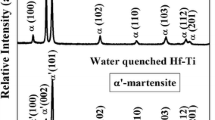Abstract
Spent nuclear fuel, in Sweden, is planned to be put in 50-mm thick copper canisters and placed in 500-m depth in the bedrock. Depending on the conditions in the repository, an uptake of hydrogen in the copper may occur. It is therefore necessary to establish how a hydrogen uptake affects the microstructure in both the surface and the bulk. Phosphorus-doped, oxygen-free copper has been cathodically charged with hydrogen for up to 3 weeks. The amount of hydrogen as a function of the distance from the surface was measured by two methods: glow discharge optical emission spectrometry and melt extraction. The penetration of the increased hydrogen content was about 50 μm. Extensive bubble formation took place during the charging. A model has been formulated for the diffusion of hydrogen into the copper, the bubble formation and growth. The model can describe the total amount of hydrogen, the number of bubbles and their sizes as a function of the distance from the surface. Bubbles close to the surface caused the surface to bulge due to the high hydrogen pressure. From the shape of the deformed surface, the maximum hydrogen pressure could be estimated with the help of stress analysis. The maximum pressure was found to be about 400 MPa, which is almost an order of magnitude larger than previously recorded values for electroless deposited copper.














Similar content being viewed by others
References
Nakahara S, Okinaka Y (1988) Mater Sci Eng A 101:227
Panagopoulos CN, Zacharopoulos N (1994) J Mater Sci 29(14):3843. doi:10.1007/BF00357357
Al-Marahleh GS, El-Amoush AS (2005) Am J Appl Sci 2(2):526
Nakahara S, Okinaka Y (1989) J Electrochem Soc 136(7):1892
Kim JJ, Byrne JG (1985) Mater Sci Eng 74(2):201
Nieh TG, Nix WD (1980) Acta Metall 28(5):557
Nakahara S (1988) Acta Metall 36(7):1669
Okinaka Y, Straschil HK (1986) J Electrochem Soc 133(12):2608
Wampler WR, Schober T, Lengeler B (1976) Philos Mag 34(1):129
Caskey JGR, Dexter AH, Holzworth ML, Louthan JMR, Derrick RG (1975) Hydrogen transport in copper. Paper presented at the Materials Science Symposium of AIME, Cincinnati, Nov 11–13
Condon JB, Schober T (1993) J Nucl Mater 207((C)):1
Angeli J, Bengtson A, Bogaerts A, Hoffmann V, Hodoroaba VD, Steers E (2003) Glow discharge optical emission spectrometry: moving towards reliable thin film analysis—a short review. J Anal At Spectrom 18(6):670
Ishikawa T, McLellan RB (1985) J Phys Chem Solids 46(4):445
Kamada K, Sagara A, Kinoshita H, Takahashi H (1988) Scr Metall 22(8):1281
Sandström R, Hallgren J (2012) J Nucl Mater 422:51
McLellan RB (1973) J Phys Chem Solids 34(6):1137
Nakahara S, Okinaka Y (1983) Acta Metall 31(5):713
Graebner JE, Okinaka Y (1986) J Appl Phys 60(1):36
Katz L, Guinan M, Borg RJ (1971) Phys Rev B 4(2):330
Sakamoto Y, Takao K (1982) Nippon Kinzoku Gakkai-si 46(3):285
Verbetsky VN, Mitrokhin SV (2000) Diffus Defect Data PtB 73:503
Acknowledgements
The authors would like to thank the Swedish Nuclear Fuel and Waste Management Co (SKB) for providing financial support of this study. The authors would also like to express their gratitude to Mr J. Ahlström, Swerea KIMAB, for his work with the hydrogen charging, Mr Martin Lundholm and Mr Mats Randelius, Swerea KIMAB, for their help with hydrogen analyses and Dr. Henrik Andersson-Östling, Dr. Rui Wu, Swerea KIMAB and Christina Lilja, SKB, for fruitful discussions and critical comments on the manuscript.
Author information
Authors and Affiliations
Corresponding author
Rights and permissions
About this article
Cite this article
Martinsson, Å., Sandström, R. Hydrogen depth profile in phosphorus-doped, oxygen-free copper after cathodic charging. J Mater Sci 47, 6768–6776 (2012). https://doi.org/10.1007/s10853-012-6592-y
Received:
Accepted:
Published:
Issue Date:
DOI: https://doi.org/10.1007/s10853-012-6592-y




